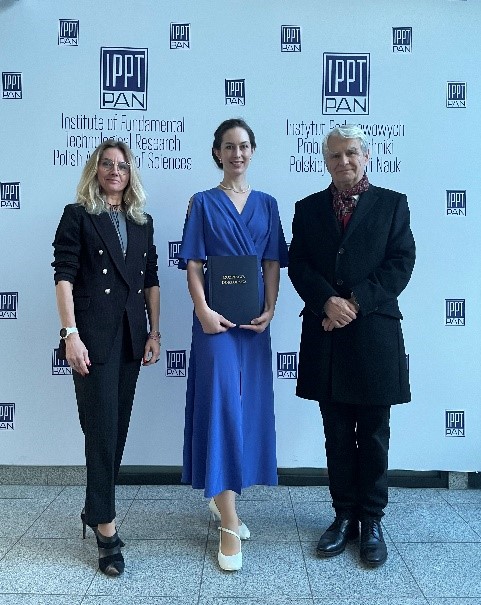
On 29 Fabruary 2024, according to the resolution of the Scientific Council of IPPT PAN, Sandra Musiał was awarded the degree of Doctor of Science in the field of Engineering and Technical Sciences in the discipline of Materials Engineering
The PhD thesis concerns the analysis of the energy conversion process during deformation of polycrystalline materials. During plastic deformation a part of the mechanical energy delivered to the material is stored, increasing its internal energy, while the rest is dissipated as heat. The energy storage rate, defined as the ratio between the stored energy increment and the plastic work increment, is a measure of the energy conversion at a given moment of the deformation process.
In the thesis an experimental method for determining the distributions of energy balance components, namely plastic work and energy dissipated as heat, throughout the entire range of elastic-plastic deformation, was developed. The method is based on the displacement and temperature fields measured using digital image correlation (DIC) and infrared thermography (IRT) techniques and the elements of both the heat transfer theory and the theory of plasticity. Although primarily experimental in nature, the thesis also includes several computational aspects concerning the determination of both the stress and heat sources fields. The experimentally determined evolution of the displacement gradient field was used as input data for the elastic-plastic material model. Using the model, the fields of the stress and the plastic strain and, consequently, the plastic work were obtained. On the other hand, the energy dissipated as heat was determined based on the transient heat conduction equation, taking into account both the heat flow within the sample and the heat exchange between the sample and the surroundings. Using the measured evolution of temperature field, the distribution of the power of heat sources was directly determined from this equation. To obtain the heat sources in the material description (in the coordinate system, in which the displacement field was determined), and therefore to express the energy balance components in the same coordinate system, a multi-step computational procedure was developed. In the considered deformation process, the energy dissipated as heat is the dominant but not the only component of the heat sources. Therefore, the other components, namely the heat of the thermoelastic effect and the heat lost to the environment by convection and radiation were also taken into account.
The developed method was applied to determine the fields of plastic work, energy dissipated as heat, and energy storage rate during uniaxial tension of austenitic steel 310S. The uniaxial tension was performed with different strain rates. It was shown that the tested steel does not exhibit a significant sensitivity to the strain rate in the considered range. However, the influence of the process duration on the temperature field and the particular terms of the heat conduction equation was significant. For the highest considered strain rate, the term associated with the increase of the sample's temperature was dominant, whereas for the lowest one, the term connected to the heat conduction in the sample was of a major importance. The evolutions of particular components of the heat sources, including the energy dissipated as heat, the heat lost by the sample to the environment due to convection and radiation, and the heat of the thermoelastic effect were also determined. Process duration was found to have significant effect on the heat exchange due to convection, with the highest contribution observed for the slowest tested process. Heat radiation, on the other hand, had an insignificant influence within the considered temperature range and could be omitted.
The obtained results confirmed that the energy storage rate is not constant throughout the plastic deformation process. At an advanced stage of the process, the values decrease rapidly in the area of the plastic strain localization, approaching zero or even becoming negative, indicating a loss of the material's ability to store energy. These findings are consistent with former research known from the literature, however, the thesis presents the determination of the energy storage rate distributions, which have not been previously reported in the literature.
Furthermore, the evolution of local crystallographic orientation during uniaxial tension of the 310S steel was determined using the Electron Backscatter Diffraction (EBSD) method. It was observed that due to significant rotations of the crystal lattice during deformation, the crystallographic texture developed towards two main texture components. As expected, for a material with an average stacking fault energy value, both the mechanical twinning and the dislocation slip played important roles as microscopic mechanisms of plastic deformation. The initial orientation of particular grains determined which of the plastic deformation mechanisms dominated in a given grain. Additionally, the presence of both dislocation slip and twinning, led to the grain fragmentation at an advanced stage of the deformation process. The twins interacted with other microstructure elements, contributing to the development of the final crystallographic texture. In the region where the energy storage rate is negative, a very fine lamellar structure composed of alternating twin-matrix layers was observed. On the basis of numerous microstructure observations and theoretical considerations present in the literature, it was found that the lamellar structure occurring in the entire area where creates favourable conditions for the propagation of both micro- and macro-shear bands. However, further research is required to confirm the presence of shear bands and the possible associated dynamic recrystallisation mechanism which is macroscopically manifested by the release of a part of the energy stored in the material.


















